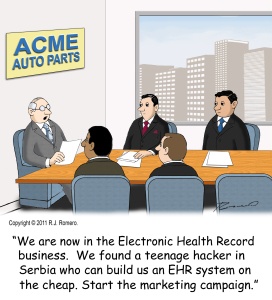As discussed in my last post, The Quality and Communication Critical to Patient-Centered Care, one of the main technology barriers to providing patient-centered healthcare is the painfully common conundrum that patient data is often housed in a number of disparate systems across multiple locations. To ensure the quality of care mandated by healthcare reform requires close communication and collaboration among all stakeholders across the patient’s continuum of care. However, as we recently saw in the sobering information breakdown at the Texas Health Presbyterian Hospital, critical patient data can and does slip through the cracks – often with tragic results. To close this information gap, and reduce the risk posed by epidemic disease, communication and data sharing needs to made easier. And fast. The key lies in Patient 360, or stakeholder access to a holistic view of the patient, and getting there requires electronic health record (EHR) interoperability.
 According to HIMSS, in the healthcare industry, the purpose of interoperability is to advance the effective delivery of healthcare for individuals and communities. Further, there are three levels of health information technology interoperability:
According to HIMSS, in the healthcare industry, the purpose of interoperability is to advance the effective delivery of healthcare for individuals and communities. Further, there are three levels of health information technology interoperability:
1. Foundational
2. Structural
3. Semantic
Semantic interoperability provides interoperability at the highest level which supports the electronic exchange of patient information among caregivers and other authorized parties via potentially disparate EHR systems to improve quality, safety, efficiency and efficacy of healthcare delivery.1
When done right, EHR interoperability goes a long way to ensuring that providers understand the patient as an individual with a medical network and, hopefully, an equally important social support network at home. The objective of interoperability is to address and solve the challenges of how healthcare systems inform the various stakeholders involved in a patient’s care as well as how the organizational facets of health information exchange (HIE) will coordinate together for the benefit of the patient.
Semantic Data Lends Order to the Chaos
The healthcare industry is fragmented – there are many stakeholders involved in the patient care process at different levels. As a result, standards have emerged as an imperative for the electronic exchange of healthcare information, but it will take years to solve even the basic challenges these standards create. In the meantime, organizations must find flexible strategies for managing data and integrating with systems that sit outside of standards-based models and bringing that information into compliance.
It seems simple enough, but when you consider interoperability and data sharing in healthcare there are fundamental challenges, particularly in regard to patient health information. Foremost, the type and variety data covers an enormous spectrum. Most often, clinical data comes to mind first, but there’s also patient behavior data, social demographics and other aspects of a patient’s activity to consider. It’s complex. And as the devil’s in the details, semantics play an important role in keeping all of this information straight – and the patient healthy.
Enabling Technology Options that Help
There are many players emerging to solve the riddle of interoperability achievement, but they’re not all created equal.  Informatics Corporation of America (ICA) has partnered with MarkLogic to offer a tested and proven path toward EHR interoperability. With clinical roots at Vanderbilt Medical Center, ICA is heading the push to make HIEs an attainable reality. With its CareAlign Interoperability Platform, authorized stakeholders in a patient’s care can access aggregated patient data from disparate EHRs. For instance, when a patient is admitted into the hospital via the emergency room, doctors can access the patient’s most up-to-date medical history and information to help them develop an effective treatment plan that avoids costly duplicate tests and procedures.
Informatics Corporation of America (ICA) has partnered with MarkLogic to offer a tested and proven path toward EHR interoperability. With clinical roots at Vanderbilt Medical Center, ICA is heading the push to make HIEs an attainable reality. With its CareAlign Interoperability Platform, authorized stakeholders in a patient’s care can access aggregated patient data from disparate EHRs. For instance, when a patient is admitted into the hospital via the emergency room, doctors can access the patient’s most up-to-date medical history and information to help them develop an effective treatment plan that avoids costly duplicate tests and procedures.
MarkLogic is the data foundation behind ICA’s CareAlign Interoperability Platform. As a Enterprise NoSQL semantic database with search engine (query anything from text documents to ontologies and facts gleaned from Linked Open Data) and government-grade security, MarkLogic is uniquely suited to act as a platform for building powerful healthcare applications. In addition, MarkLogic supports semantic interoperability. This is key because the crux of Patient 360 is not only the ability to share patient data from provider to provider, or consumer to provider, but to be able to include the eye-opening crucial context of the patient information being communicated.
So, if semantic data platforms are now available why aren’t all healthcare networks already well on the path toward EHR interoperability? According to Noland Joiner, CTO Commercial Healthcare, before migrating from RDBMS to an Enterprise NoSQL database, healthcare organizations often make the assumption that it’s a matter of “rip and replace.” But, that’s not the case. On the contrary, it’s not cost effective for a healthcare provider to start refactoring all of its systems. In reality it doesn’t have to be an outright choice between the legacy database and Enterprise NoSQL because MarkLogic can co-exist within a legacy environment. In fact, MarkLogic can extend the life and increase the production of a provider’s existing database.
To learn more, view our on-demand webinar, Patient 360: From Abstract to Reality.

Fiona Ehret-Kayser

Latest Stories in Your Inbox
Subscribe to get all the news, info and tutorials you need to build better business apps and sites
